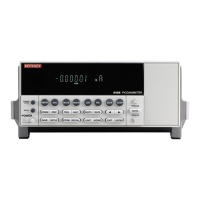I-2 Applications Guide Model 6485 Picoammeter Instruction Manual
Measurement considerations
Some considerations for making accurate amps measurements are summarized as follows.
Additional measurement considerations are covered in Appendix C. For comprehensive
information on precision measurements, refer to the Low Level Measurements handbook,
which is available from Keithley Instruments.
It is critical that the picoammeter perform the measurement without interfering with the
flow of current in the circuit, possibly affecting operation or inducing additional errors.
Voltage burden is the terminal voltage of a picoammeter, and ideally this voltage should be
zero (no resistive effect). Some meters, such as DMMs, utilize a shunt resistor to measure
the voltage drop across a known resistance, and a typical burden of 200mV is not unusual.
The Keithley 6485 uses an alternative approach referred to as a feedback picoammeter,
where the voltage burden is simply the input voltage of an operational amplifier. Further-
more, since the input voltage of the operational amplifier is the output voltage divided by
the gain (typically 500,000) the voltage burden is in the microvolt range.
Leakage currents and guarding
Leakage currents are generated by high resistance paths between the measurements circuit
and nearby sources. These currents can considerably degrade the accuracy of low current,
measurements. Some ways to reduce leakage currents are to use good quality insulators,
reduce humidity, and use guarding. Guarding can also be used to reduce the effect of shunt
capacitance in the measurement circuit.
One way to reduce leakage currents is to use good quality insulators when building the test
circuit. Some good quality insulators are Teflon, polyethylene, and sapphire. Avoid materi-
als such as phenolics and nylon. Refer to Keithley’s Low Level Handbook for additional
information on choosing the best insulator.
Humidity may also degrade low current measurements. The amount of water an insulator
absorbs will vary depending upon the insulator. It is best to choose an insulator on which
water vapor does not readily form a continuous film. Sometimes this is unavoidable if the
material being measured absorbs water easily, so it is best to make the measurements in an
environmentally controlled room. In some cases, an insulator may have ionic contami-
nants and, especially in high humidity, a spurious current may be generated.
Another way to reduce leakage currents is to use guarding. A guard is a conductor con-
nected to a low impedance point in the circuit that is nearly at the same potential as the
high impedance lead being guarded. Guarding can isolate the high-impedance input lead
of the picoammeter from leakage current due to voltage sources.
Guarding may also be necessary to prevent leakage current due to text fixturing. Figure I-1
shows a high-megohm resistor supported on two insulators mounted in a metal test fixture.
This circuit is guarded by connecting the LO of the picoammeter (A) to the metal case.
This will put the top of the right insulator at almost the same potential as the bottom. The

